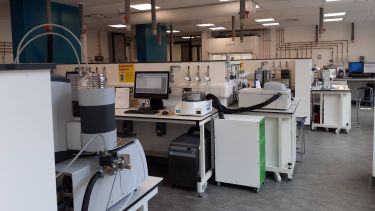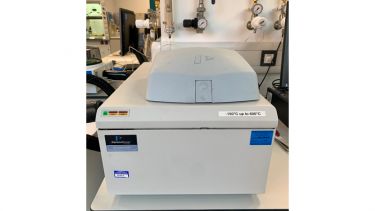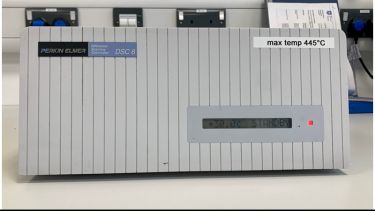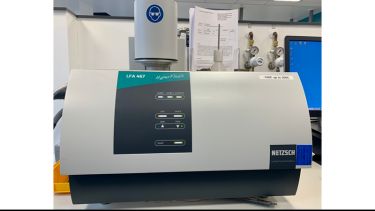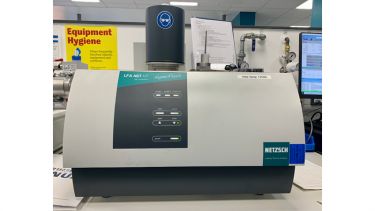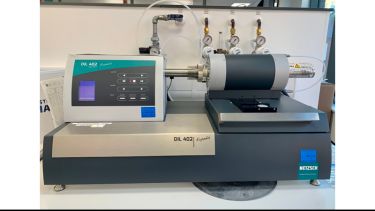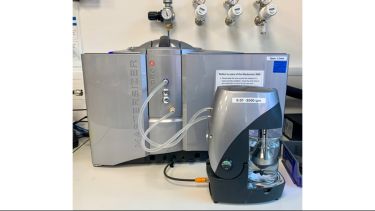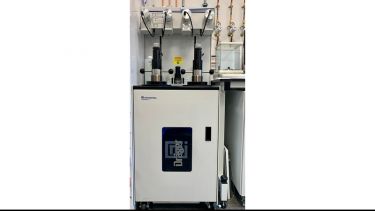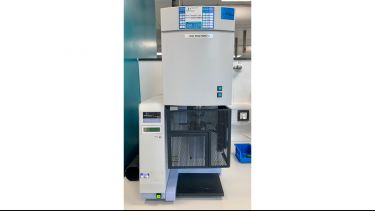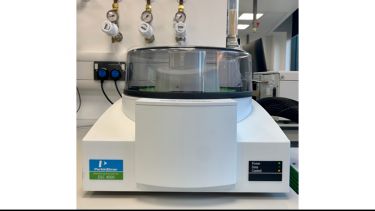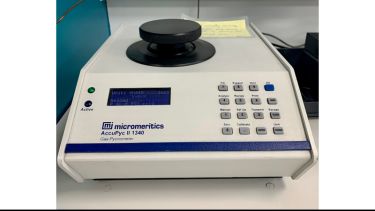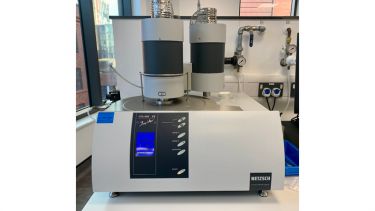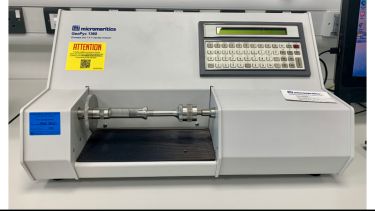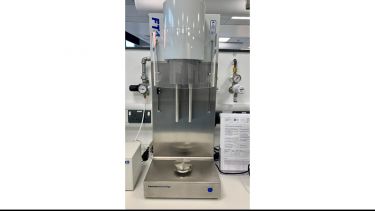Basic Characterisation
The Materials Basic Characterisation Laboratory, located in the Royce Discovery Centre, hosts state-of-the-art instrumentation offering the latest analytical techniques. Our range of cutting-edge instrumentation is fully calibrated and serviced to ASTM and ISO standards.
We provide a bespoke service to all external customers, and offer equipment access to students and staff across the Department, Faculty, and the University. Full databases and reports are provided as part of our Professional Service package.
See our full Equipment List
The Basic Characterisation Lab offers an analytical service, which involves the process of measuring and determining the physical, chemical, mechanical, and Microstructural properties of materials.
This process leads to the higher-level of understanding required to resolve important issues, such as the cause/s of failure/s and process-related problems, allowing the manufacturer to make critical materials decisions.
THERMAL ANALYSIS
| PROPERTY MEASURED: | PROVIDES INFORMATION ON: |
TECHNIQUES USED: |
|---|---|---|
| Mass change | Degradation and composition properties, loss of water/solvents, decarboxylation, pyrolysis, oxidation, %filler, %ash, purity | Thermogravimetric analysis (TGA) |
| Dimension change | Glass transition, softening points, rates of expansion/contraction | Thermomechanical analysis (TMA) and Dilatometry |
| Change in heat capacity | Phase changes, melting temperature, crystalline and amorphous behaviour, curing and degree of cure, glass transition, purity, degree of polymerisation | Differential scanning calorimetry (DSC) and Differential thermal analysis (DTA) |
| Heat transfer per unit time | Thermal diffusivity and conductivity, specific heat capacity | Flash diffusivity |
SPECTROSCOPY
Molecular characterisation of solid, liquid, and powder via FTIR and UV-Vis spectroscopy allows information about the structure and composition of the material to be gathered.
| PROPERTY MEASURED: | PROVIDES INFORMATION ON: | TECHNIQUES USED: |
|---|---|---|
| To obtain the infrared spectrum of transmission or absorption of materials |
|
FTIR-400-8000cm-1 range |
| To obtain the spectroscopy based on the absorption of ultraviolet light or visible light by chemical compounds |
|
UV-Vis spectrometer |
PARTICLE CHARACTERISATION
Particle characterisation of particles by particle shape, size, density, surface properties, and microstructure.
| PROPERTY MEASURED: | PROVIDES INFORMATION ON: | TECHNIQUES USED: |
|---|---|---|
| For measuring the particle size and particle size distribution of materials |
|
Malvern Mastersizer 3000 PSA |
| For measuring the density of materials |
|
Micromeritics AccuPyc II 1340 |
| For measuring the Pore size and porosity of solid or powder samples |
|
AutoPore 9620 |
| For measuring powder flow properties and powder behaviour |
|
FT4 Powder Rheometer |
OUR EQUIPMENT
| TECHNIQUES | INSTRUMENT AVAILABLE |
|---|---|
| Thermogravimetric analysis (TGA) | PerkinElmer Pyris 1 TGA |
| Thermomechanical analysis (TMA) and Dilatometry | Netzsch Dilatometer DIL 402 Expedis, PerkinElmer Diamond TMA |
| Differential scanning calorimetry (DSC) and Differential thermal analysis (DTA) | TA Instruments Q600 SDT, PerkinElmer DSC6, PerkinElmer Diamond DSC, PerkinElmer DSC 4000, Netzsch STA 449 F3 Simultaneous TGA/DSC |
| Flash diffusivity | Netzsch Flashline - LFA 467 Hyperflash - LT, Netzsch Flashline - LFA 467 HyperFlash - HT |
| Particle Characterisation | Malvern Mastersizer 3000 PSA, Micromeritics AccuPyc II 1340, AutoPore 9620, Micromeritics GeoPyc 1360, FT4 Powder Rheometer |
| Molecular Spectroscopy | PerkinElmer Frontier FTIR, PerkinElmer Lambda 900 UV/Vis/NIR spectrometer |
A 20-position auto-sampler which allows the measurement of a large number of samples and is particularly useful for running samples overnight.
Allows heat flow determination between -90°C (via the use of an Intercooler III system) and 600°C. Sub-ambient temperatures are particularly amendable to the thermal studies of polymers. The diamond system also allows fast heating rates, so-called 'hyper-DSC' with rates up to 500°C/min (in helium), and therefore allowing kinetic studies.
PERKIN ELMER DSC6
Our Differential Scanning Calorimeters allow a range of transformations to be identified by measuring heat flow. The instruments measure the energy difference between a sample and a reference material as a function of time or temperature when both are subjected to a controlled temperature program. Both the sample and reference are maintained at the same temperature and the power input needed, related to heat flow.
DSC is an important technique for looking at phase and enthalpy changes. Our DSC6 has a maximum temperature of 445°C.
TA INSTRUMENTS Q600 SDT
Our DSC-TGA allows the concurrent measurement of both mass change (TGA) and heat flux (DTA/DSC). The instrument has a measurement range of RT - 1500°C with a normal heating rate of 10°C/min (other heating rates can be used).
The advantage of using an STA system is that both energy and mass changes are directly comparable.
NETZSCH FLASHLINE - LFA 467 HYPERFLASH LT
This equipment holds a xenon lamp as a flash source and the cost-effective veidium antmonide (iNsB) detector to cover a range of temperatures between -100 to +500°C.
NETZSCH FLASHLINE - LFA 467 HYPERFLASH HT
This equipment holds a xenon lamp as a flash source and the more advanced Mercury Cadmium Telluride (MCT) detectors to cover a range of temperatures between RT to 1250°C.
NETZSCH DILATOMETER DIL 402 EXPEDIS
A novel NanoEye optoelectronic sensor with unmatched resolution over the entire measuring range, which allows direct sequential measurement of samples of different lengths and with different expansion behaviour at maximum precision. Temperature range from RT to 1500°C. The process takes place in a vacuum and at high temperature.
MALVERN MASTERSIZER 3000 PSA
Our Mastersizer system allows particle size distribution to be measured via laser diffraction. The capabilities are for dry and wet dispersion, in either water or IPA. The system has a measurement range of 0.01μm - 3000μm.
AUTOPORE 9620
Besides offering speed, accuracy, and a wide measurement range, Mercury Porosimetry permits you to calculate numerous sample properties such as: pore size distributions, total pore volume, total pore surface area, median pore diameter, and sample densities (bulk and skeletal).
Our Frontier FTIR allows spectroscopic investigations of the mid infra-red regions. Samples can be analysed using direct transmission - either as a raw material or in a KBr matrix - or via specular reflectance.
PERKIN ELMER LAMBDA 900 UV/VIS/NIR SPECTROMETER
Our Lambda 900 Spectrophotometer allows spectroscopic investigation of the UV, visible, and near-IR regions of your sample material. Sample holders can accept either solid films or plates, or cuvettes for liquid samples.
NETZSCH STA 449 F3 SIMULTANEOUS TGA/DSC
Our team of experts in Royce at the University of Sheffield would love to discuss how we could work together to create the next generation of advanced materials.
For general enquiries contact:

